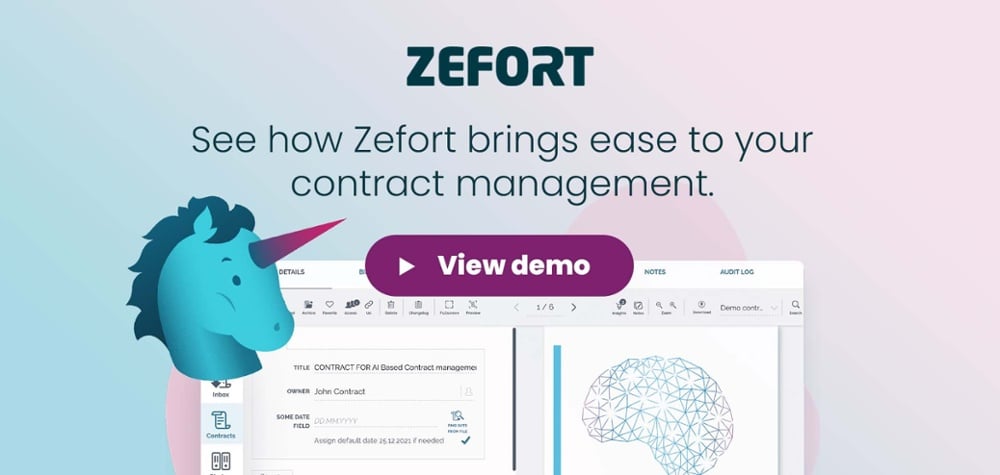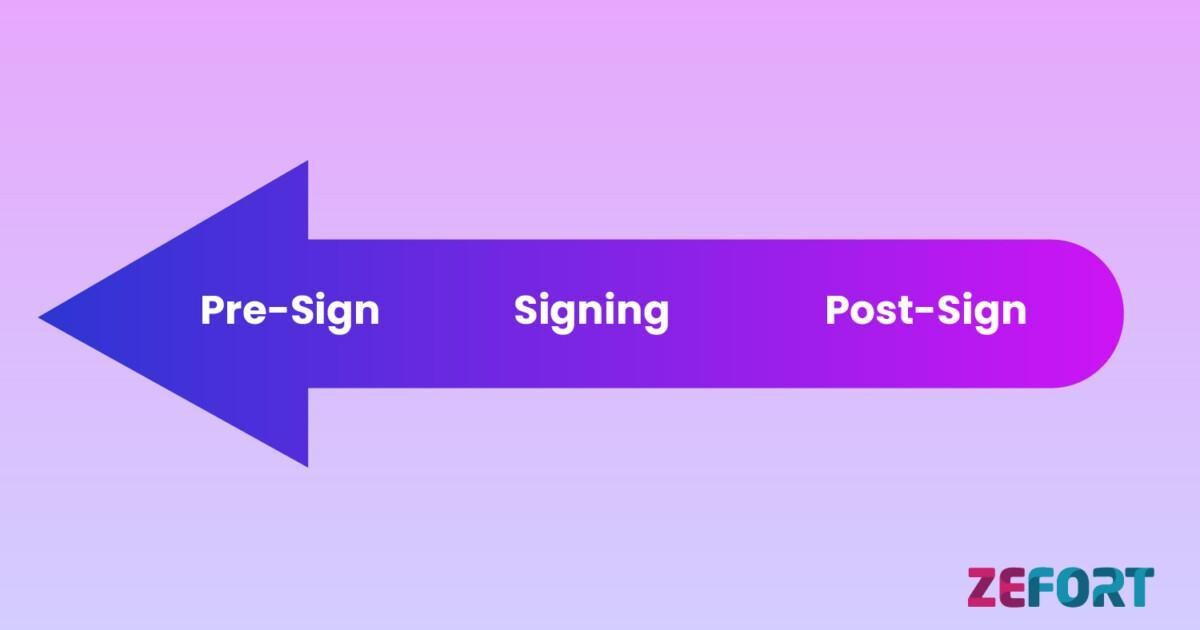Exploring the Benefits of Contract Lifecycle Management for Small Businesses
Contracts form the backbone of any business, laying the foundation for successful partnerships, safeguarding interests, and ensuring transparent operations. But for small businesses, contract management can be an overwhelming challenge, often burdened by manual processes and a lack of efficient tools. This is where Contract Lifecycle Management (CLM) steps in, revolutionizing the way small businesses handle their contractual obligations.
By streamlining and automating the entire contract lifecycle, CLM offers an array of benefits that extend far beyond mere paperwork.
In this article, we will dive into the world of CLM, exploring how it can empower small businesses to thrive, compete with larger enterprises, and unlock their true potential. So buckle up, as we embark on a journey to unravel the wonders of Contract Lifecycle Management for small businesses.
Understanding Contract Lifecycle Management (CLM)
Here’s what you should know about Contract Lifecycle Management:
- Contract Lifecycle Management (CLM) refers to the process of managing all stages of a contract, from initiation to execution to expiration. It involves the creation, negotiation, approval, storage, and analysis of contracts.
- CLM is a strategic approach that helps businesses streamline their contract processes, improve efficiency, reduce risk, and enhance compliance.
- It involves automating and digitizing contract workflows, allowing businesses to centralize contracts, track their status, and optimize their performance.
- CLM encompasses various activities, such as drafting contracts, negotiating terms, generating approvals, managing revisions, monitoring deadlines, and tracking contract performance.
- It enables businesses to have better control and visibility over their contracts, ensuring that they meet legal and regulatory requirements, and align with business objectives.
- CLM software solutions are available that facilitate the management of contracts and provide features such as contract templates, e-signatures, contract repositories, document versioning, and contract analytics.
- Small businesses can benefit from CLM by streamlining their contract processes, reducing manual errors, improving communication and collaboration, and optimizing contract performance.
- CLM helps small businesses mitigate risks, improve supplier and customer relationships, save time and money, and gain insights through contract analytics.
- By understanding and implementing CLM, small businesses can elevate their contract management practices, drive operational efficiency, and enhance overall business performance.
Importance of Contract Lifecycle Management for Small Businesses
Contract Lifecycle Management holds significant importance for small businesses. Managing contracts effectively is crucial as it directly impacts the overall success of the business. CLM allows small businesses to streamline their contract processes, ensuring efficiency and accuracy throughout the entire contract lifecycle.
By implementing CLM, small businesses gain better control and visibility over their contracts. They can track and manage contract milestones, such as renewal dates, payment schedules, and compliance obligations, effectively minimizing the risk of missing crucial deadlines or terms.
Furthermore, CLM helps small businesses improve compliance and risk management. It provides a centralized repository for storing and accessing contracts, enabling businesses to easily monitor contract terms, obligations, and compliance requirements. This helps mitigate legal and regulatory risks and facilitates adherence to industry standards.
Contract lifecycle management also enhances efficiency and time savings for small businesses. It automates repetitive tasks, such as contract generation, approval workflows, notifications, and document storage, reducing manual errors and administrative burden. This allows employees to focus on more strategic activities, reducing overall contract cycle time and improving productivity.
Additionally, CLM contributes to cost reduction and financial optimization. It prevents revenue leakage by ensuring accurate billing and adherence to pricing terms. CLM systems also enable small businesses to identify cost-saving opportunities, renegotiate contracts, and eliminate unnecessary expenses.
Effective CLM enables small businesses to build better relationships with their suppliers and customers. It facilitates collaboration, allowing both parties to access and update contract information in real-time. This transparent and streamlined communication leads to stronger partnerships and improved customer satisfaction.
Moreover, CLM helps small businesses mitigate legal disputes. With a clear record of contract terms and history, businesses can proactively address issues before they escalate. CLM systems provide audit trails, enabling businesses to easily track changes, resolve conflicts, and maintain an accurate legal record.
Ultimately, contract lifecycle management empowers small businesses to leverage analytics and gain valuable data insights. By analyzing contract data, businesses can identify trends, optimize vendor performance, negotiate better terms, and make informed business decisions.
In conclusion, the importance of contract lifecycle management for small businesses lies in its ability to streamline processes, increase control and visibility, mitigate risks, save time and costs, improve relationships, and enable data-driven decision-making. By embracing CLM, small businesses can optimize their contract management practices and drive overall business success.
Benefits of Contract Lifecycle Management for Small Businesses
Streamlined Contract Creation and Execution
- Centralized repository: Contract Lifecycle Management provides small businesses with a centralized repository to store and manage all contracts, making it easy to access and retrieve essential documents.
- Template customization: CLM allows businesses to create standardized contract templates that can be customized based on specific requirements. This streamlines the contract creation process and ensures consistency across all agreements.
- Automated workflows: CLM software automates various stages of the contract lifecycle, such as drafting, reviewing, approving, and signing. This eliminates manual tasks and reduces the risk of errors, ensuring contracts are executed efficiently.
- Collaboration and negotiation: CLM systems facilitate collaboration among multiple stakeholders involved in the contract process. Real-time collaboration and negotiation tools ensure effective communication, track changes, and speed up the finalization of contracts.
- Version control: CLM software maintains a complete history of contract versions, allowing small businesses to track changes and revisions over time. This ensures transparency and minimizes the chances of using outdated or incorrect contract versions.
- Audit trail: CLM solutions provide an audit trail that captures all activities related to the contract, including amendments, approvals, and signatures. This enhances transparency and enables businesses to review and track contract progress at any given time.
- Integration with e-signature tools: Many CLM platforms integrate with electronic signature tools, eliminating the need for manual signing and paperwork. This expedited signing process reduces delays and enhances the overall contract execution efficiency.
- Notifications and reminders: CLM systems can send automated notifications and reminders for contract milestones, such as renewal dates, termination periods, or review timelines. This feature ensures that contracts are managed proactively and are not overlooked.
By streamlining the contract creation and execution process, CLM enables small businesses to reduce administrative burden, minimize errors, and enhance overall efficiency in managing their contractual obligations.
Improved Contract Visibility and Control
One of the key benefits of Contract Lifecycle Management for small businesses is the improved contract visibility and control it offers. With CLM, businesses gain a comprehensive and centralized view of all their contracts, enabling easy access to important contract details and critical information.
Contract visibility refers to the ability to track the entire lifecycle of a contract, from creation to expiration. It allows businesses to monitor the status, key dates, and obligations associated with each contract in real-time. By having a clear understanding of where the contracts are in the process, businesses can effectively manage their contractual commitments and avoid any potential issues or delays.
Moreover, CLM empowers businesses to have better control over their contracts. It provides features such as version control, document management, and automated workflows that streamline the contract management process. With improved control, businesses can ensure that contracts are being executed correctly, terms and conditions are being followed, and compliance requirements are being met.
Additionally, CLM enables businesses to set up alerts and notifications for important contract milestones, such as renewal dates or termination clauses. This proactive approach helps in preventing missed deadlines and ensures that businesses can take necessary actions in a timely manner, such as renegotiating terms or terminating contracts if required.
Overall, improved contract visibility and control through CLM brings transparency and efficiency to the contract management process. Businesses can easily locate, track and manage contracts, eliminating paper-based processes or relying on scattered files and emails. This not only saves time but also reduces the risk of overlooking critical contract details, leading to better business outcomes and stronger relationships with customers and suppliers.
Increased Efficiency and Time Savings
By implementing Contract Lifecycle Management , small businesses can automate various tasks such as contract creation, approval workflows, and document storage, eliminating the need for manual processes and saving significant time.
CLM systems offer centralized databases and searchable contract repositories, enabling quick access to contract information, reducing the time spent searching through stacks of paperwork or emails.
With CLM, businesses can set up automated alerts and notifications for contract milestones, renewals, and deadlines, reducing the chances of missed opportunities or costly penalties.
CLM streamlines collaboration and communication among internal teams and external stakeholders, enabling real-time collaboration on contract development, negotiation, and approvals, resulting in faster turnaround times and increased efficiency.
Implementation Process of Contract Lifecycle Management for Small Businesses
Identifying Business Needs and Objectives
- Assess current contract management practices: Evaluate how contracts are currently managed within the organization. Identify any pain points, inefficiencies, or gaps in the existing processes.
- Define business goals: Clearly articulate the specific objectives that the organization wants to achieve through the implementation of contract lifecycle management . These goals could include improving contract visibility, reducing risks and errors, increasing efficiency, or enhancing compliance.
- Identify specific pain points: Identify the challenges and issues faced by the organization when it comes to contract management. This could be related to manual and time-consuming processes, lack of contract visibility, difficulty in tracking contract milestones, compliance issues, or poor supplier/customer relationships.
- Gather stakeholder input: Involve key stakeholders from various departments such as legal, procurement, sales, and finance to understand their specific contract-related pain points and requirements. This helps in gaining a holistic view of the organization’s needs.
- Analyze scalability requirements: Consider the future growth and scalability plans of the organization. Determine if the CLM solution needs to accommodate a higher volume of contracts, additional users, or integration with other systems as the business expands.
- Evaluate regulatory and compliance requirements: Identify any industry-specific regulations or compliance standards that need to be adhered to. This may include data privacy regulations, contract governance rules, or industry-specific legal requirements.
- Consider budget and resource constraints: Assess the available budget and resource capacity of the organization to implement and maintain a CLM solution. This includes evaluating whether an on-premise or cloud-based solution is more suitable based on the organization’s IT infrastructure and capabilities.
- Prioritize key requirements: Compile a list of the most critical requirements based on the pain points, goals, stakeholder input, and scalability considerations. This helps in selecting a CLM solution that aligns with the organization’s specific needs and delivers the most value.
By thoroughly understanding the business needs and objectives, organizations can effectively identify the right CLM solution and tailor it to improve contract management processes, mitigate risks, optimize costs, and enhance overall business operations.
Selecting a suitable CLM solution
Selecting a suitable Contract Lifecycle Management solution is a critical step for small businesses. It involves evaluating different software options available in the market and choosing one that aligns with your specific business needs and objectives. Factors to consider include user-friendliness, scalability, integration capabilities, and cost.
The selected CLM solution should have the necessary features to streamline contract management processes and support efficient collaboration between stakeholders. Thorough research, demos, and consultations are essential in making an informed decision regarding the most suitable CLM solution for your small business.
Configuring and Customizing the CLM system
Configuring and customizing the CLM system is the process of tailoring the software to meet the specific needs and requirements of a small business. This step is crucial to ensure that the CLM system aligns with the company’s unique processes, workflows, and contractual requirements.
During the configuration phase, the CLM system is typically customized to reflect the company’s contract templates, approval workflows, and data fields. This allows the system to generate contracts automatically based on predefined templates, ensuring consistency and accuracy.
Additionally, the system can be configured to align with the company’s contract approval processes, specifying the appropriate stakeholders and setting up notification triggers for reviewing and approving contracts. This customization enables efficient collaboration and prevents any bottlenecks in the approval process.
Furthermore, the CLM system can be tailored to integrate with other business systems, such as CRM or ERP software, allowing for seamless data exchange and eliminating the need for duplicate data entry. Integration enhances efficiency and ensures that contract-related information is consistent and up-to-date across the organization.
Customization may also involve configuring the system to enforce compliance with legal and regulatory requirements, such as data privacy laws or industry-specific regulations. This ensures that contracts are aligned with relevant policies and guidelines, reducing legal risks and potential disputes.
Overall, configuring and customizing the CLM system plays a vital role in optimizing the efficiency and effectiveness of contract management within a small business, enabling streamlined processes, improved accuracy, and enhanced compliance.
Testing and Launching the CLM system
Testing and Launching the CLM system is a crucial phase in the implementation process for small businesses. It involves conducting thorough testing of the CLM system to ensure its functionality and compatibility with existing systems. This phase also includes training employees on how to use the CLM system effectively. Once testing is complete, the CLM system is officially launched, and small businesses can begin reaping the benefits of improved contract management and efficiency.
Challenges and Considerations for Small Businesses in Implementing CLM
Implementing Contract Lifecycle Management can bring numerous benefits to small businesses, but it is important to be mindful of the challenges and considerations that may arise during the process. Here are some key points to consider:
- Limited resources: Small businesses often have limited financial and human resources, which can pose challenges in terms of investing in a CLM system and allocating personnel for implementation.
- Complexity: CLM implementation involves configuring the system to match the unique needs of the business, which can be complex and time-consuming. Small businesses may require additional support or expertise to navigate this process effectively.
- Resistance to change: Introducing new processes and technologies may meet resistance from employees who are accustomed to traditional methods. It is crucial to address this resistance through effective communication, training, and change management strategies.
- Integration with existing systems: Integrating a CLM system with existing business systems, such as CRM or ERP, can be a challenge. It is essential to ensure compatibility and seamless data flow between systems to maximize efficiency.
- Scalability: Small businesses may face specific challenges related to scalability when implementing CLM. It is crucial to select a CLM solution that can accommodate the growth of the business and effectively handle increased contract volume.
- Data security and privacy: Contract management involves handling sensitive and confidential information. Small businesses need to ensure that their CLM system provides robust security measures, data encryption, and compliance with relevant regulations (e.g., GDPR).
- Training and user adoption: Proper training and user adoption are key to deriving maximum benefits from a CLM system. Small businesses should invest time and resources to train employees and ensure they understand how to use the system effectively.
- Return on investment (ROI): Small businesses need to carefully evaluate the potential ROI of implementing a CLM system.
It is important to assess the costs associated with implementation, training, and ongoing maintenance against the anticipated benefits and value the CLM system will bring.
Overall, while there may be challenges, small businesses can overcome them by addressing these considerations and utilizing appropriate support and guidance throughout the CLM implementation process. By doing so, they can enjoy the numerous benefits of effective contract lifecycle management, including improved efficiency, cost reduction, and better business relationships.
Final thoughts
Contract lifecycle management offers numerous advantages for small businesses. Managing contracts efficiently and effectively is crucial for streamlining operations and minimizing risks. CLM simplifies the entire contract process, from creation to execution and beyond. It optimizes contract creation and enables businesses to easily draft, negotiate, and customize contracts to suit their specific needs.
CLM also enhances contract visibility and accessibility, allowing businesses to easily search and retrieve important contract information when needed. This ensures that businesses stay on top of contract deadlines, renewals, and obligations, minimizing the risk of missed opportunities or costly penalties. Additionally, CLM centralizes contract storage, eliminating the need for physical filing systems and reducing the chances of losing or misplacing vital documents.
Moreover, CLM facilitates improved collaboration and communication among various stakeholders involved in the contract lifecycle. It enables seamless collaboration during contract negotiation, ensuring all parties are aligned and reducing the likelihood of confusion or disputes. With CLM, businesses can also establish clear approval workflows and track the progress of contracts, ensuring accountability and preventing delays.
Furthermore, CLM offers enhanced contract analytics and reporting capabilities. It provides businesses with valuable insights into contract performance, enabling them to identify trends, negotiate better terms, and maximize profitability. By leveraging data-driven analytics, small businesses can make informed decisions and optimize their contract strategies for growth.
Lastly, CLM helps small businesses navigate compliance and regulatory requirements more effectively. It provides tools and features to ensure contracts comply with relevant laws, regulations, and industry standards. This reduces compliance risks and potential legal disputes, allowing businesses to operate within the boundaries of applicable laws and regulations.
In conclusion, the benefits of implementing contract lifecycle management for small businesses are significant. From streamlining contract processes to improving collaboration, enhancing visibility, and ensuring compliance, CLM empowers small businesses to operate more efficiently, reduce risks, and achieve their contractual objectives.






